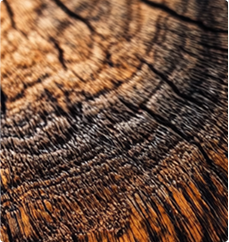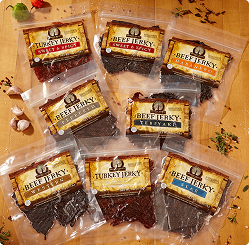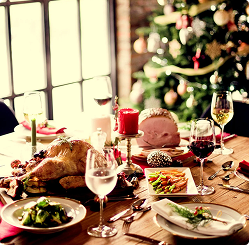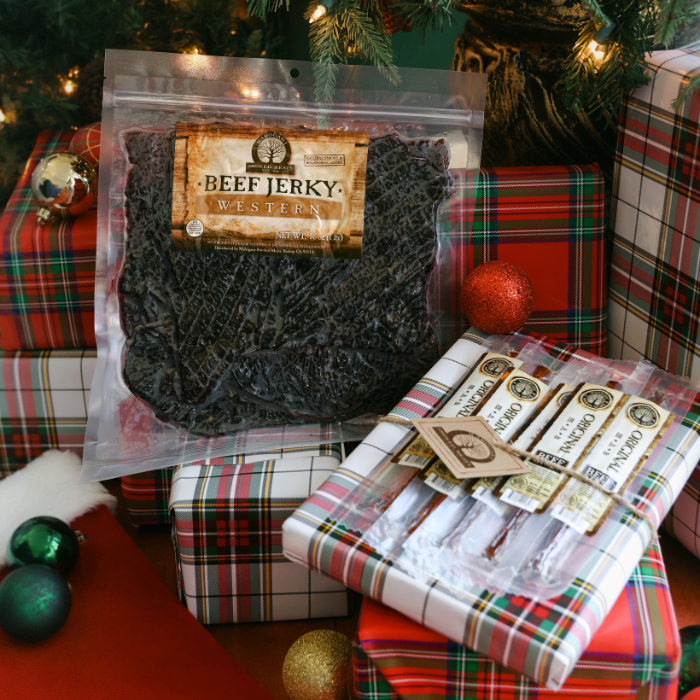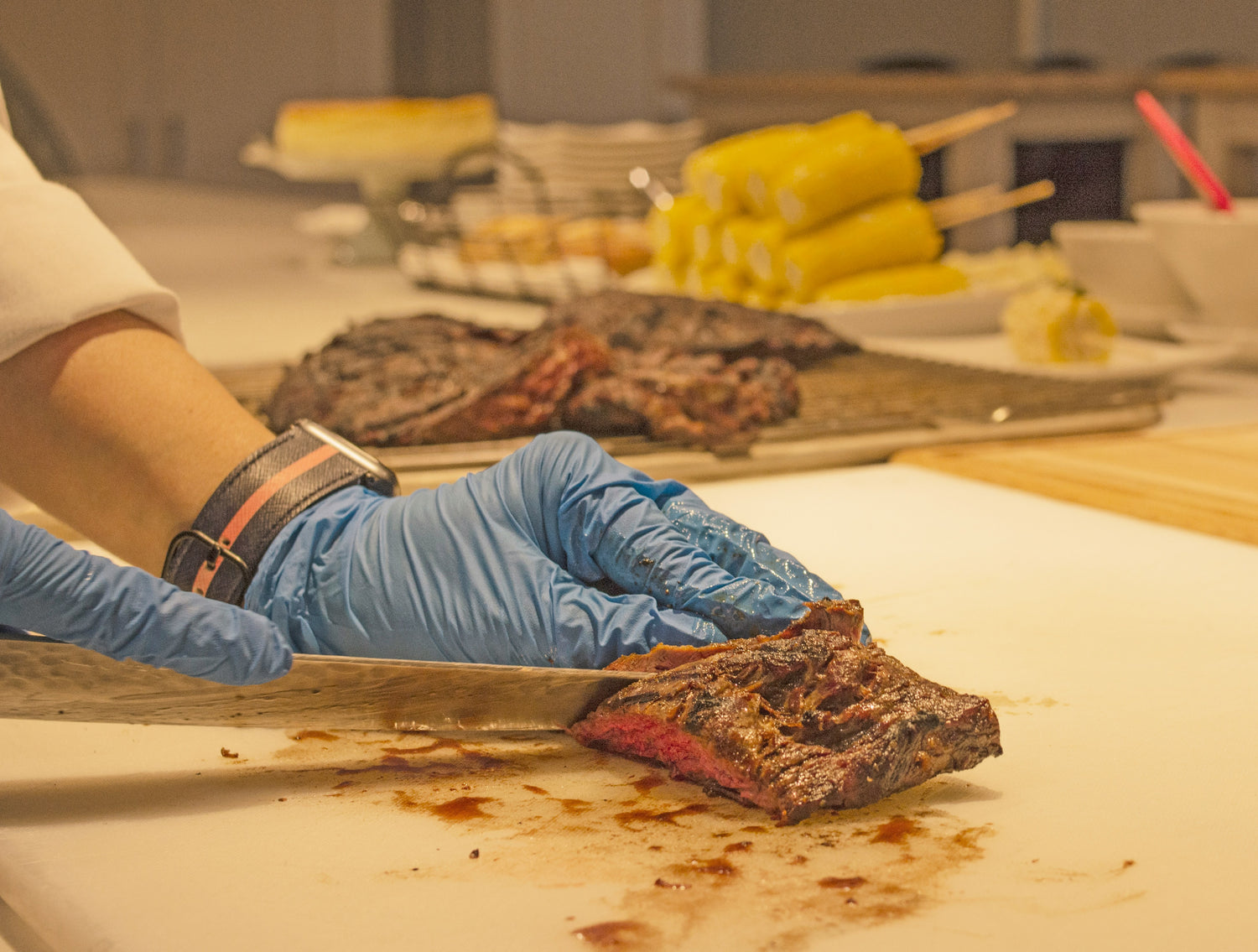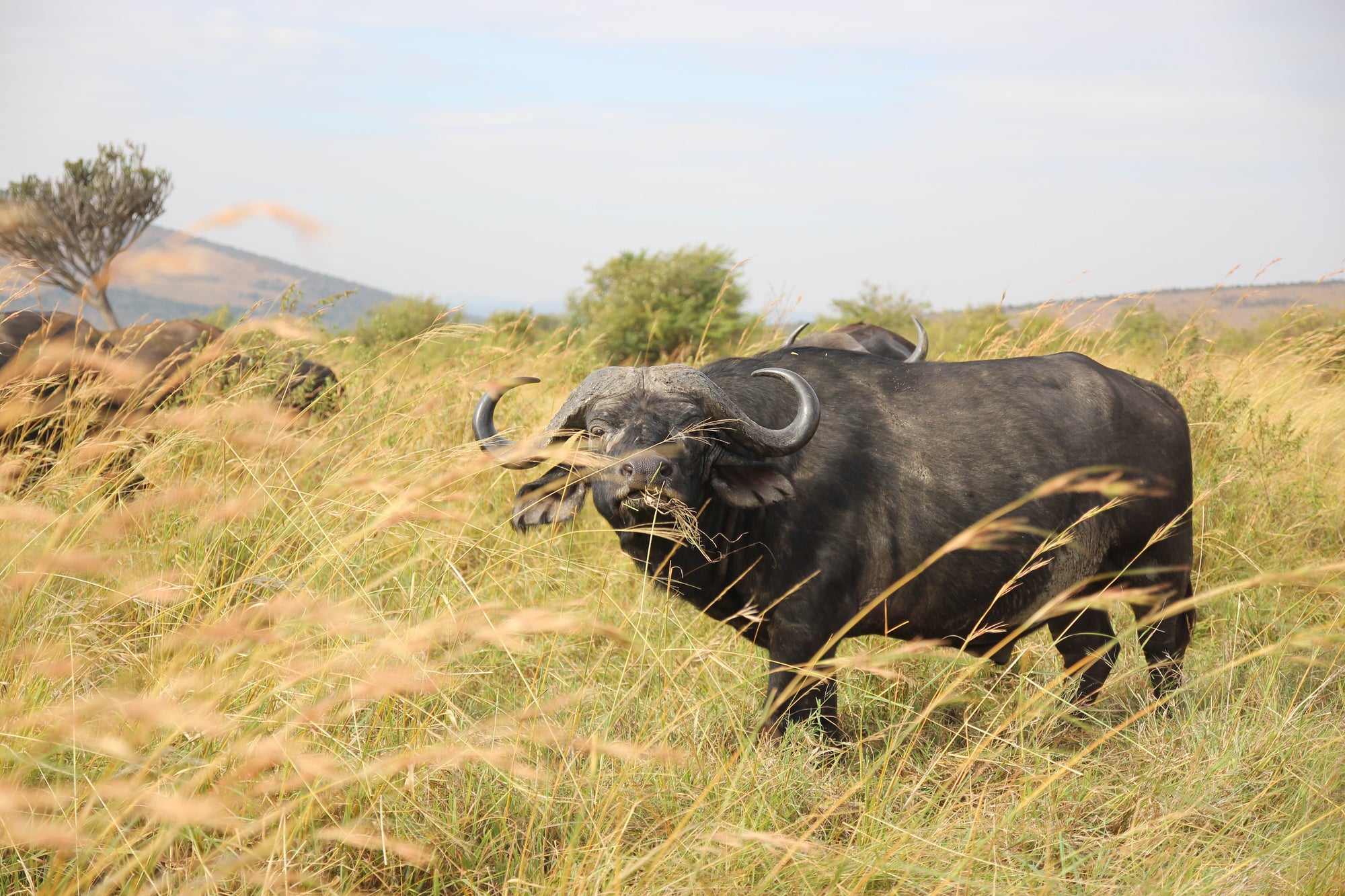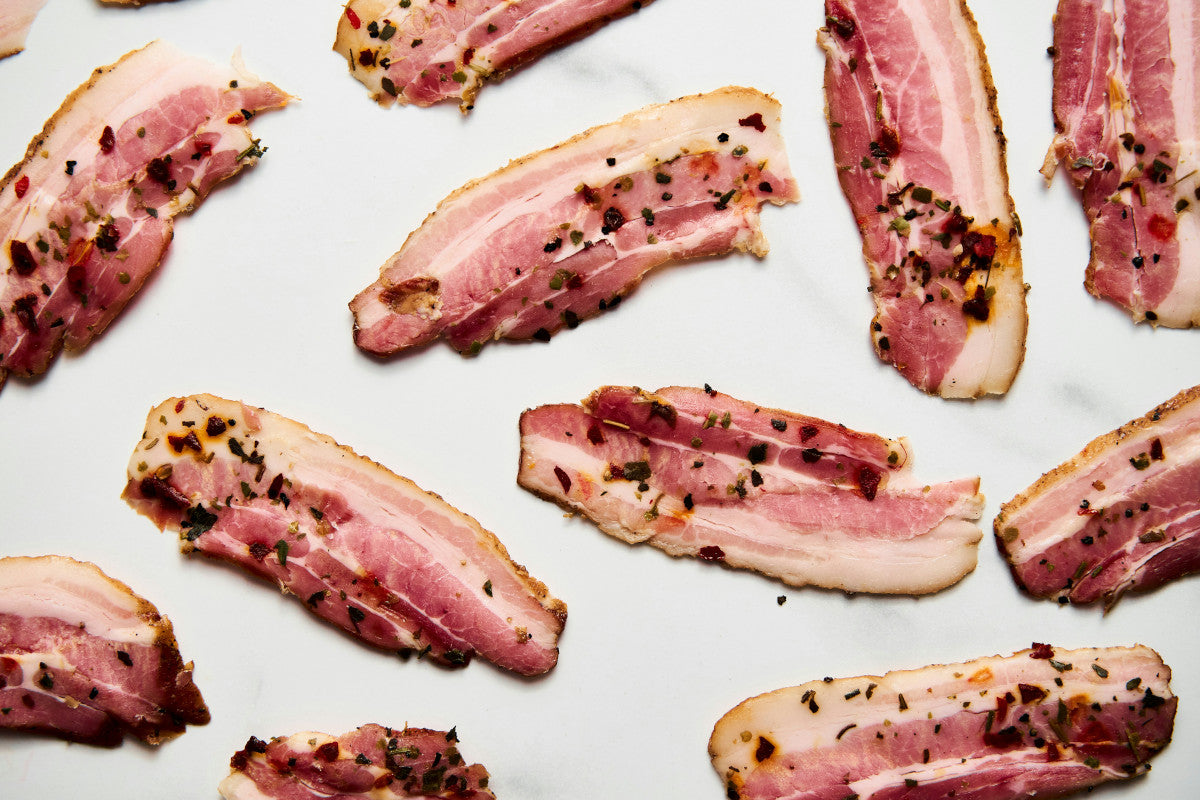Beef jerky has stood the test of taste and time, continuing to captivate snack enthusiasts worldwide. Its enduring popularity is rooted in its health benefits, offering a high protein, low-fat option that satisfies hunger on the go.
The tantalizing flavors that span from classic to adventurous have only broadened its appeal, while its cost-effectiveness makes it a smart choice for savvy snackers.
But have you ever stopped to wonder…how is beef jerky made? Behind every bite lies a meticulous process of meat selection, careful slicing, flavorful marinating, and precise dehydrating - all culminating in the perfect piece of jerky.
Not only will we demystify the art of making beef jerky step by step, but we'll also introduce you to the finest selection of beef jerky for sale at Mahogany Smoked Meats. Prepare to embark on a journey into the world of jerky-making and discover the best that snacking has to offer.
How is Beef Jerky Made?
So, how is beef jerky made exactly? There’s a lot that goes into bringing premium jerky to life - but we’ll leave you with a clear understanding of the 5 most important steps below. First things first - choosing the best cut for beef jerky.
Meat Selection
The journey to making exceptional beef jerky begins with the selection of meat. This is true of types of jerky, such as buffalo jerky recipes, elk jerky recipes, fish jerky recipes, and all other beef jerky alternatives.
High-quality, lean cuts of beef are essential because fat can cause the jerky to spoil faster. Typically, cuts like top round, bottom round, and flank steak are preferred due to their lower fat content and fibrous texture.
These cuts not only ensure a longer shelf life but also provide the ideal chewiness associated with jerky. Moreover, using leaner cuts like these ensures you’re making the healthiest jerky possible. You get fewer beef jerky calories and more protein. If you ever wonder - why is jerky so expensive? It’s because you get what you pay for.
The selected beef is then thoroughly inspected to meet stringent quality standards, ensuring that only the best meat proceeds to the next stage of jerky making.
Slicing and Preparation
Once the meat has been chosen, it's sliced against the grain into thin strips. This technique is crucial as it impacts the texture of the final product; slicing against the grain ensures that the jerky is easier to chew.
The thickness of the slices also plays a role in the dehydration process, with thinner slices drying more quickly and evenly. Uniformity in slice thickness leads to consistent drying and, therefore, a uniformly textured jerky.
The meat is then trimmed of any remaining fat to further enhance preservation and ensure a clean bite. You can learn more about how thick to cut beef jerky in our blog.
Marinating
Now how is beef jerky made into a delicious, flavor packed snack from raw beef? Marinating. This step infuses the beef with flavors and tenderizes it.
Recipes for marinades can vary greatly, from simple salt and pepper for a traditional beef jerky recipe to complex blends of soy sauce, Worcestershire, vinegar, spices, and even sweeteners like honey or brown sugar.
The meat strips are submerged in the marinade and refrigerated, typically for several hours or overnight. This allows the flavors to penetrate deeply, and the acidic components of the marinade to begin tenderizing the meat, setting the stage for a rich taste experience.
Dehydrating
Now comes the fun part of how beef jerky is made - dehydrating. The marinated beef strips are laid out on racks and placed in a dehydrator or an oven set to a low jerky dehydrator temp.
The goal is to remove moisture slowly without cooking the meat. This low-and-slow approach ensures that the jerky retains its nutritional value while becoming shelf-stable.
Now, you may be wondering - how long do you dehydrate beef jerky? The dehydration process can take several hours, during which the meat loses a significant portion of its weight as water content evaporates.
The exact timing depends on the thickness of the slices and the desired level of dryness. Master jerky makers know that the process cannot be rushed - patience is key to achieving the perfect texture that's neither too brittle nor too moist.
For more insights on the process behind smoked jerky vs dehydrated jerky, explore our blog. Let’s move on to the final step in how beef jerky is made, though: packaging.
Packaging
Once dehydration is complete, the jerky is cooled to room temperature to prevent condensation during packaging, which could reintroduce moisture and lead to spoilage. Packaging is typically done in airtight containers or vacuum-sealed bags to prevent oxidation and maintain freshness.
Oxygen absorbers are often added to remove any residual air, further extending shelf life. But, how long does beef jerky last - and can you freeze beef jerky? We have more insights on how to store beef jerky along with tips on noticing the signs of expired beef jerky if you want to learn more.
The packaging is also where branding comes into play. Labels with nutritional information, flavor profiles, and branding help distinguish the product in a competitive market.
Why Beef Jerky is Still One of the Most Popular Snacks in the World
There you have it - how beef jerky is made! But what makes this simple little snack so special? Why is it still one of the most popular choices for on-the-go or even at-home enjoyment? There are 3 reasons: health, flavor, and cost.
Health Benefits of Jerky
Beef jerky is an excellent source of protein, vital for muscle repair and growth, making it a favorite among athletes and fitness enthusiasts. Jerky is also low in carbohydrates, fitting well into low-carb and ketogenic diets.
Beyond the beef jerky macros, it provides essential minerals like iron and zinc, which are important for immune function and metabolism. So, is beef jerky good for weight loss? It certainly can be!
Delicious Flavor Varieties
The diversity of flavors available in beef jerky also contributes to its enduring popularity. From traditional flavors like hickory-smoked and teriyaki to innovative combinations like chili lime and whiskey BBQ, there's a jerky to satisfy every palate.
The versatility of marinades and seasonings allows for endless creativity, and many brands now offer gourmet options, exotic meats, and even vegetarian alternatives.
Cost Effective Snacking
Beef jerky’s long shelf life means less waste, and its portability provides a convenient source of nutrition without the need for refrigeration.
Per serving, jerky can be more economical than other high-protein snacks, especially when considering its satiety factor, which can lead to reduced overall food intake.
Now That You Know How Beef Jerky is Made, Treat Yourself to the Best of the Best at Mahogany Smoked Meats!
There’s no question that beef jerky is good for you or that this delicious snack belongs in your arsenal. The only question is, who makes the best beef jerky? Look no further than Mahogany Smoked Meats!
At Mahogany Smoked Meats, we honor the time-honored traditions of jerky making while infusing our craft with the distinctive richness of mahogany smoke.
Our century-long legacy in Bishop has been built on the foundation of our deep log-pit smoking method, a technique that sets us apart and imbues our jerky with unparalleled flavor.
Our commitment to excellence is unwavering, as we continue to hand-slice our meats in small batches, ensuring that each piece holds the essence of our dedication.
Our Sweet n' Spicy Beef Jerky strikes a perfect balance between sugary highs and spicy kicks, making it a favorite for those who crave a dynamic taste experience.
The Teriyaki Beef Jerky, with its harmonious blend of sweet and savory, offers a classic flavor that transports your senses to the heart of traditional jerky goodness.
For the more adventurous palate, our Chipotle Bourbon Beef Jerky melds the smokiness of chipotle with the rich, oaky notes of bourbon, creating a bold and robust profile.
And for purists, our Peppered Beef Jerky delivers a straightforward, peppery zest that highlights the quality of the meat.
Every flavor we offer is crafted with all-natural ingredients, free from preservatives, nitrates, or MSG. We stand by our 100% satisfaction guarantee because we believe in the quality of our products.
We don’t just have the best online beef jerky, though - you can also round out your snacking arsenal with elk jerky for sale, wild boar jerky for sale, buffalo jerky for sale, fish jerky for sale, and many other meaty treats.
So, spoil yourself today with the best of the best, and savor the difference that deep, rich mahogany smoke makes.
Final Thoughts on How Beef Jerky is Made
The art of making beef jerky is a blend of tradition and precision, from selecting the finest cuts of lean beef to the careful marinating, dehydrating, and packaging that ensures each bite is bursting with flavor.
At Mahogany Smoked Meats, we elevate this process with our signature mahogany smoke, creating a product that's not only delicious but steeped in the heritage of our century-old smokehouse.
You can learn more about buffalo jerky vs beef jerky, air fryer beef jerky, who invented beef jerky, carne seca vs beef jerky, is beef jerky keto, is beef jerky gluten free, smoking multiple meats at once, and more in our blog.
As you've journeyed through the craft of how beef jerky is made, let your next step be a taste of our legacy. Discover the rich, smoky difference of our premium beef jerky and indulge in a snack that's truly exceptional.
From the best elk jerky to the best fish jerky, the best buffalo jerky, and of course, the finest beef jerky available - Mahogany Smoked Meats offers a treasure trove of meat treats waiting to be discovered.







